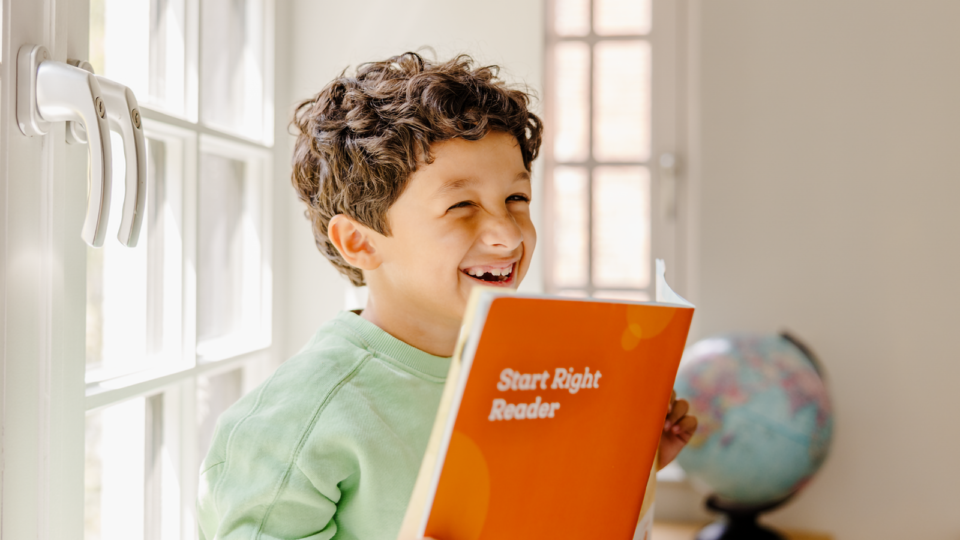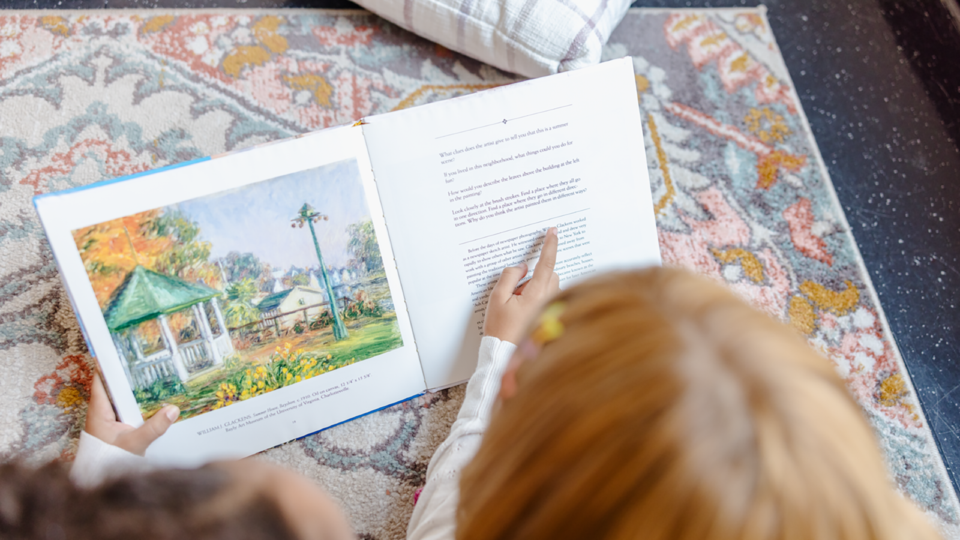
Do you recognize the first line of this nursery rhyme: “Jack and Jill went up the hill”?
How about this tongue twister: “Peter Piper picked a peck of pickled peppers”?
Common nursery rhymes and tongue twisters are not only fun childhood activities, but they are also powerful tools for developing phonological awareness. When young children engage in these activities, they are practicing essential literacy skills. This blog post describes more research-backed phonological awareness examples and activities.
What is phonological awareness?
One way to describe phonological awareness is the ability to recognize and manipulate the sounds within words. As defined by the Institute of Education Sciences, phonological awareness is “the understanding that speech can be broken down into parts, or units of sound, and the ability to manipulate those parts.” This ability to manipulate sounds makes phonological awareness the cornerstone of early literacy development.
Why phonological awareness matters
Phonological awareness is a key indicator of reading success. HMH Into Reading author Dr. Shane Templeton explains: “Phonological awareness skills are important foundational knowledge for the effective development of letter-sound relationships.” Children need to understand the structure of spoken language before they can effectively learn how printed words represent those sounds. Children develop phonological awareness by moving from recognizing larger sound units, such as whole words and syllables, to identifying the smaller sounds within words. This progression helps children connect spoken language to written text.
There is a large body of research, such as this summary from the Massachusetts Department of Education, showing that students with well-developed phonological awareness are in a position to become good readers over time.
What are some examples of phonological awareness?
Phonological awareness is an umbrella term with a continuum of four distinct skills under the umbrella: word awareness, syllable awareness, onset and rime awareness, and phonemic awareness. Importantly, these skills along the continuum can be developed simultaneously. The majority of the examples and activities below are adapted from Book Smart: How to Develop and Support Successful, Motivated Readers, written by Dr. Anne Cunningham, one of the authors of Into Reading, and Dr. Jamie Zibulsky. Book Smart provides a deeper dive into the topic of phonological awareness, including numerous activities to support other essential literacy skills, such as oral language development, concepts of print, alphabet knowledge, writing, spelling, and vocabulary.
Word awareness
Word awareness means that students can understand that sentences are made up of words, for example, I see the cat = I + see + the + cat. Also, word awareness means that compound words are made up of smaller words, for example, toothbrush = tooth + brush.
Word awareness, syllable awareness, and phonemic awareness skills can each be supported through identifying, blending, segmenting, and deleting, as described below.
Word awareness activities adapted from Book Smart, listed in order of increasing difficulty:
Identifying words within a sentence: Clap each word in a simple sentence. For example, I + see + the + cat, then ask the students to say the sentence while clapping for each word.
Blending words within sentences: Ask the students to repeat a sentence after you more quickly. For example, say, I (pause) run (pause) fast. In response, the students should respond, I run fast.
Blending words within compound words: Ask the students what word they get when they put together particular words that form compound words. For example, tooth (pause) brush? In response, the students should respond, toothbrush.
Segmenting words within sentences: Tell the students a short sentence and then ask the students to break apart each word they hear. For example, for The water is cold, students should respond, The (pause) water (pause) is (pause) cold.
Segmenting words within compound words: Tell the students a compound word and ask them to break it apart and to say both words they hear. For example, say, butterfly. The students should respond, butter (pause) fly.
Deleting the initial word in a compound word: Ask the students to say ladybug, then ask the students to say it without lady. The students should respond, bug.
Deleting the final word in a compound word: Ask the students to say ladybug, then ask the students to say it without bug. The students should respond, lady.
Syllable awareness
Syllable awareness means that students can break up a word into syllables and sound them out. For example, recognizing that the words “exercise” and “butterfly” have three syllables and being able to sound out each syllable displays syllable awareness.
Syllable awareness activities adapted from Book Smart, listed in order of increasing difficulty:
Identifying syllables in words: Ask the students how many syllables they hear when clapping out a simple word. For example, ask the students to clap with you, as you clap out hap – py. Students should clap each syllable with you, and then respond two syllables.
Blending syllables in words: Ask the students to blend a multiple-syllable word with you. For example, say “What do you get when you put together ba – nan – a?” The students should respond banana.
Segmenting syllables in words: Tell the students a multiple-syllable word and ask them to break the word into syllables. For example, say, “Tell me the syllables in computer.” The students should respond com – pu – ter.
Deleting the initial syllable in a word: Tell students, “We are going to take away syllables from words to see what we have left.” For example, ask the student to say water and then ask them to say it without wa. The students should respond ter.
Deleting the final syllable in a word: Similar to the above, ask students to say water without ter. The students should respond wa.
To gain further practice in recognizing syllables, you can do activities such as:
Playing musical instruments: Use tambourines, bells, shakers, drums, buckets, or rhythm sticks to emphasize each syllable in various words.
Clapping syllables: Have students clap each syllable to emphasize syllables in words.

Onset and rime awareness
Onset and rime awareness means that students recognize the sounds of a syllable’s starting and ending parts. This skill is more difficult than syllable awareness, as the students must understand that each syllable can be broken down into onsets and rimes. Onset refers to the initial consonant sound, blend, or digraph that comes before the vowel in the syllable, and rime represents the remaining sound in the syllable. Even more difficult is the understanding that multiple-syllable words have multiple onsets and rimes. It is recommended that you begin with one-syllable words for onset-rime awareness activities. Note that students are not expected to learn the terms onset and rime, but they should learn the general concept.
Onset and rime activities adapted from Book Smart, listed in order of increasing difficulty:
Blending one-syllable words: Ask students, “What do you get when you put together /c/ (pause) /at/?” Students should respond cat.
Segmenting one-syllable words: Tell students a word with a single initial consonant and ask them to say the first sound and then the rest of the word. For example, say hat. The students should respond /h/ (pause) /at/.
To support students in understanding onset and rime, you could also do activities such as:
Matching games: Give students several pictures (for example, familiar objects, animals, food, or clothes) and have them match the pairs that rhyme.
Rhyming songs: Have students practice rhyming exercises (such as singing nursery rhymes) to help them understand how letters and sounds correspond.
Phonemic awareness
Phonemic awareness is the most difficult of the phonological awareness skills. Phonemic awareness means that students can perceive and manipulate phonemes. Phonemes are the smallest units of sound within words.
Phonemic awareness activities adapted from Book Smart, listed in order of difficulty:
Identifying phonemes: Using picture cards of familiar objects, choose a target card and then ask students to find the one that begins with the same sound. For example, to practice initial sound, show the students a picture of a ball, a spoon, a dog, and a book. Ask students to point to the one that starts with the same sound as ball. Students should respond by pointing to the picture of the book. To practice identifying which phonemes are different, you can do a similar activity by asking students to point to the picture that starts with a different sound than ball. You can further increase the difficulty by asking students to identify picture cards with words that end in the same/different final sound, and the same/different middle sound.
Blending phonemes: Ask students to combine individual phonemes to form a word. For example, “What word do you get when you put together /c/ (pause) /a/ (pause) /t/.” Students should respond cat.
Segmenting phonemes: Tell students a word and then ask students to tell you the sounds they hear. For example, say bed. Students should respond /b/ (pause) /e/ (pause) /d/.
Deleting phonemes: Tell students a word and then ask them to repeat it back without the initial phoneme. Increase the difficulty by telling students a word and then asking them to repeat it back without the final phoneme. For example, say hat, and then ask the students to say it without /h/. The students should respond /at/.
To support students in understanding phonemes, you could also do activities such as:
Tongue twisters (or alliteration sentences): Have students practice tongue twisters (like “Peter Piper picked”) to identify the common first sound in each word.
Elkonin boxes (sound boxes): Have students listen to a word and move a letter magnet or token into boxes for each phoneme: “cat” uses three boxes (/c/ /a/ /t/)
Monitoring progress in phonological awareness
Assessment plays a critical role in monitoring student progress in phonological awareness. According to Reading Rockets, assessing phonological awareness skills can help identify students who need more support in acquiring beginning reading skills. Tools like the MAP Reading Fluency can deliver efficient, automatically scored progress monitoring to assess young readers. Educators can also use informal methods, such as observations or exit tickets, to assess students.
Early reading intervention for students who need additional help with phonological awareness is crucial, as children who encounter reading difficulties often require additional support in reading.
More support for developing phonological awareness
There are numerous ways to support students’ phonological awareness, many of which you are likely already doing. For example, provide a print-rich environment including a variety of books across genres and subject areas; engage students in rich conversations and read-alouds, with a deliberate focus on expanding students’ vocabulary; engage students in shared writing activities, by modeling and talking through what you are writing.
To learn more, check out other HMH Shaped blogs on this topic, such as “What Is Phonological Awareness?,” “Progression of Phonological Awareness Skills,” and “The Phonological Awareness Umbrella,” which explores the visual umbrella metaphor in depth, and “9 Fun Phonological Awareness Activities,” which provides more examples of phonological awareness and teaching ideas. Additionally, for more tips on teaching early literacy skills, read our blog, “Teaching Foundational Literacy Skills.”
***
HMH core, intervention, and supplemental programs are rooted in the science of reading. Find out more about our evidence-based approach to teaching a child to read.
Be the first to read the latest from Shaped.














